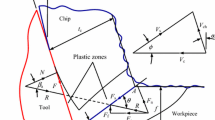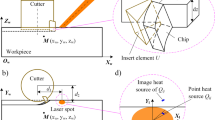Abstract
Milling temperature directly affects surface integrity and fatigue life, which is one of the important physical parameters in the process of machining. At present, the prediction of cutting temperature is mainly focusing on orthogonal cutting and turning; there is little research on the prediction of milling temperature of workpiece. The main idea is to discretize the cutting time and heat source, which is learning from the idea of milling force modeling. The moving heat source method is used to predict the workpiece temperature rise in milling process. The geometric kinematics of five-axis machining motion is analyzed. The temperature rise contribution can be calculated in the shear zone based on orthogonal cutting model through coordinate transformation. The proposed model is verified by experiments and 4-axis milling of cylinder surface temperature field is analyzed by simulation. This method can be extended to the temperature prediction of other processing methods, such as five-axis machining and turn-milling compound machining.









Similar content being viewed by others
References
Abukhshim NA, Mativenga PT, Sheikh MA (2006) Heat generation and temperature prediction in metal cutting: a review and implications for high speed machining. Int J Mach Tools Manuf 46:782–800
Pittalà GM, Monno M (2011) A new approach to the prediction of temperature of the workpiece of face milling operations of Ti-6Al-4V. Appl Therm Eng 31(2):173–180
Nemetz AW, Daves W, Thomas K, Ecker W, Teppernegg T, Czettl C, Krajinović I (2018) FE temperature- and residual stress prediction in milling inserts and correlation with experimentally observed damage mechanisms. J Mater Process Technol 256:98–108
Davies MA, Ueda T, M'Saoubi R, Mullany B, Cooke AL (2007) On the measurement of temperature in material removal processes. CIRP Ann Manuf Technol 56:581–604
Le Coz G, Dudzinski D (2014) Temperature variation in the workpiece and in the cutting tool when dry milling Inconel 718. Int J Adv Manuf Technol 74(5–8):1133–1139
Augspurger GT, Da Silva D, Schraknepper P, Bergs MT (2020) Model-based monitoring of temperatures and heat flows in the milling cutter. Int J Adv Manuf Technol 107:4231–4238
Yan S, Zhu D, Zhuang K, Zhang X, Zhu D (2014) Modeling and analysis of coated tool temperature variation in dry milling of Inconel 718 turbine blade considering flank wear effect. J Mater Process Technol 214(12):2985–3001
Komanduri R, Hou ZB (2000) Thermal modeling of the metal cutting process: Part I-Temperature rise distribution due to shear plane heat source. Int J Mech Sci 42(9):1715–1752
Richardson DJ, Keavey MA, Dailami F (2006) Modelling of cutting induced workpiece temperatures for dry milling. Int J Mach Tools Manuf 46:1139–1145
Jiang F, Liu Z, Wan Y, Shi Z (2013) Analytical modeling and experimental investigation of tool and workpiece temperatures for interrupted cutting 1045 steel by inverse heat conduction method. J Mater Process Technol 213(6):887–894
Feng Y, Hsu F-C, Lu Y-T (2020) Temperature prediction of ultrasonic vibration-assisted milling. Ultrasonics 108:106212
Lin S, Peng F, Wen J, Liu Y (2013) An investigation of workpiece temperature variation in end milling considering flank rubbing effect. Int J Mach Tools Manuf 73:71–86
Yan R, Zeng HH, Peng FY (2016) Analytical modeling and experimental validation of workpiece temperature variation in bull-nose end milling. Int J Adv Manuf Technol 86:155–168
Jiao L, Wang X, Qian Y (2015) Modelling and analysis for the temperature field of the machined surface in the face milling of aluminium alloy. Int J Adv Manuf Technol 81(9–12):1797–1808
Qi-sen C, Yu L, Dong Q-s (2020) Modeling and experimental validation on temperature diffusion mechanism in high-speed bone milling. J Mater Process Technol 286:116810. https://doi.org/10.1016/j.jmatprotec.2020.116810
Zhou R, Yang W (2019) Analytical modeling of machining induced residual stresses in milling of complex surface. Int J Adv Manuf Technol 105:565–577
Zhou R, Yang W, Yang K (2016) Force prediction models for helical end milling of nickel-aluminum bronze. Int J Adv Manuf Technol 86:1487–1498
Funding
This study is supported by the starting research fund from the Hubei University of Arts and Science.
Author information
Authors and Affiliations
Corresponding author
Additional information
Publisher’s note
Springer Nature remains neutral with regard to jurisdictional claims in published maps and institutional affiliations.
Rights and permissions
About this article
Cite this article
Zhou, R. Analytical model of workpiece surface temperature prediction in 4-axis milling process. Int J Adv Manuf Technol 111, 2155–2162 (2020). https://doi.org/10.1007/s00170-020-06255-0
Received:
Accepted:
Published:
Issue Date:
DOI: https://doi.org/10.1007/s00170-020-06255-0




